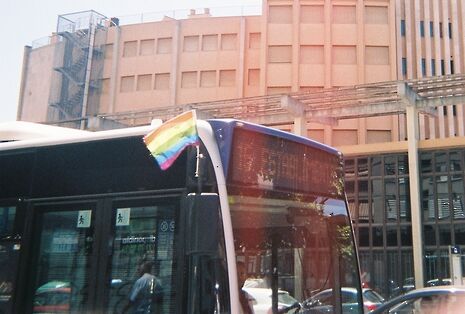Invisi-Bi-lity: the erasure of bisexual identity
In his first column, Joel Lucyszyn explores how a discourse of binaries invalidates the experiences of bisexual people.

“A man’s heterosexuality will not put up with any homosexuality, and vice versa.”
Sigmund Freud wrote these words in the first half of the 20th century. As you’d expect, my initial reaction was similar to what contemporary criticism has found in Freud: that he is often archaic, outdated, and bigoted. Yet the voice seemed eerily familiar, it was not the imagined tones of a long-dead Austrian, but in clear-as-day modern English. Freud’s theorisation of bisexuality exemplifies many of the prejudices we still hear today. In many cases, it is Freud himself who gave rise and credence to the opinions which contaminate the way we think and speak about bisexuality. But this claim was particularly important – it performed biphobia in its most pernicious form – through erasure. The clause does not contain the word ‘bisexuality’: it’s a binary of ‘heterosexuality’ and ‘homosexuality’ which not only denies the existence of the bisexual person, but also denies them existence in language. This is an experience that all bisexual people face: to be defined in negation, the ‘invisible zone’ between homo and hetero. This column series seeks to discuss bisexual identity and biphobia in its many forms, but before it can do that, it has to explore ‘invisiBIlity’.
“As Sandra Bernhard puts it: ’Lots of people think that bisexual means cowardly lesbian’.”
The visibility of bisexuals has always been lower than gay men and lesbians (and obviously, straight people). This lack of visibility is the product of various forms of biphobia: the most overt form being the simple denial of bisexuality as a valid sexual identity (bierasure). To understand why bierasure is so huge, we need to examine our “ideologically bound inability to imagine bisexuality concretely” (Michael du Plessis). Much of the main biphobic patterns of thought originate in Freud, who doesn’t see bisexuality as a stable orientation. It is a ‘primary ground’ before homo/hetero divisions, before a person decides to pursue the same sex or the opposite. Without prying into the usual bioessentialism and gender binary at work in Freud, we can easily see where one of the main modern bierasury thought patterns comes from: that bisexuality is a ‘middle ground’ before ‘fully coming out’, or that the person is ‘indecisive’; as Sandra Bernhard puts it: “Lots of people think that bisexual means cowardly lesbian.”
“...many people simply don’t believe bisexuality is real.”
Bisexuality is not a middle ground before deciding on gay/straight, nor is it – and this strain of thought is as equally damaging – an identity forged through a merging of hetero/homo. The amount of times I’ve heard someone refer to bisexuality as ‘half gay’ or ‘half straight’ is startling, and like the middle ground myth, it comes down to the same base fact: many people simply don’t believe bisexuality is real. Terms like ‘fence sitter’ are coded with instability, and consequently, invalidity. The famous bipride slogan counters this succinctly: “Not half gay, not half straight, but totally bisexual”.
These prejudices are not only destabilising and discriminatory towards people who identify as bisexual, but in some cases, has denied bisexual people knowledge of their bisexuality until much later in life. It has left generations of bisexuals confused: people who didn’t fit into the false binary of homo/hetero were at a loss of how to describe their sexuality. In a study of members of the San Francisco Bisexual Center, sociologists Colin Williams, Martin Weinberg and Douglas Pryor reported on how ‘invisiBIlity’ impacted various members. One woman told the researchers, “I thought I had to be either gay or straight”, while a bisexual man hadn’t heard the word bisexual until he was 26: 2Up until that point, the only way that I could define my sexual feelings was that I was either a latent homosexual or a confused heterosexual.”
“Bisexuals today still consider their sexuality through a language tainted with ‘inbetween’, ‘confused’ or ‘indecisive’”
So firmly situated in a false sexual binary of homo and hetero, these individuals experienced years of confusion and distress because the word simply hadn’t entered their lexicon. Their eureka moments (oh – so that’s what I am) often did not occur until their late 20s. Though the discourse surrounding sexuality has somewhat progressed since the 90s, bisexuals today still consider their sexuality through a language tainted with ‘inbetween’, ‘confused’ or ‘indecisive’. This erasure is evident even in my social interactions: I always remember looks of confusion when I was sporting nail varnish with a women partner (‘she must be awfully close with her gay best friend!’). It wasn’t until last year that I truly saw my identity as solid – I’ve felt much better for it – but that realization should have come much earlier.
While recognising the validity of bisexual identity, it is also important to recognise the consequences of existing outside a homo/hetero binary. Bisexuals face biphobia from straight and queer people alike: whether it’s because of our queerness or perceived ‘heterosexual privilege’ in the LGBT community. In many cases, existing outside this binary is to not exist at all. However, bisexuality is not a concept, a middle ground, a theory, nor a pre/post sexual ideal. It’s a valid sexual orientation, and it’s about time we focussed on visi-BI-lity
 News / Cambridge academics stand out in King’s 2026 Honours List2 January 2026
News / Cambridge academics stand out in King’s 2026 Honours List2 January 2026 Interviews / You don’t need to peak at Cambridge, says Robin Harding31 December 2025
Interviews / You don’t need to peak at Cambridge, says Robin Harding31 December 2025 Comment / What happened to men at Cambridge?31 December 2025
Comment / What happened to men at Cambridge?31 December 2025 News / Varsity’s biggest stories of 202531 December 2025
News / Varsity’s biggest stories of 202531 December 2025 Features / “It’s a momentary expression of rage”: reforming democracy from Cambridge4 January 2026
Features / “It’s a momentary expression of rage”: reforming democracy from Cambridge4 January 2026









